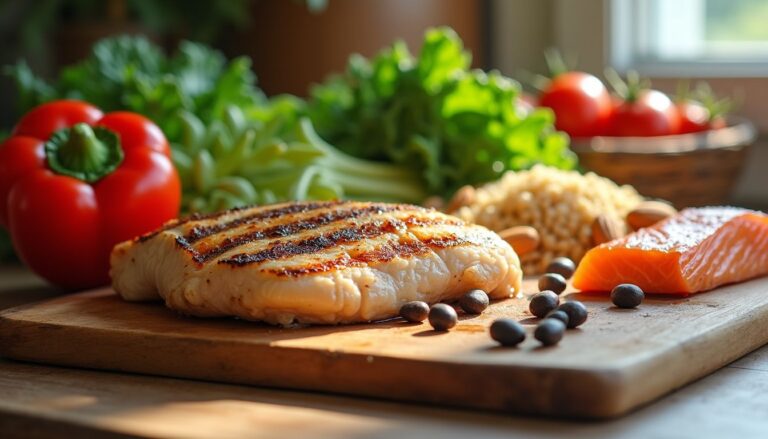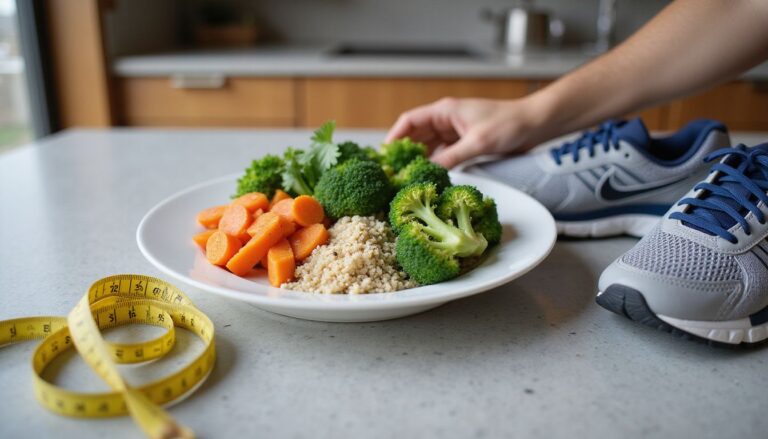Low Fat Diet Plan: Your Ultimate Guide To Cutting Saturated Fat And Eating Healthily
Our Nutrition Assistant AI Suite will transform your body. You will lose fat, get toned, and build muscle. Gain confidence and optimal health.
If you want a simple way to cut fat, this guide will help. A low-fat diet plan shows you how to lower saturated fat, the type that raises LDL cholesterol. You will learn what to eat, what to limit, and how to make smart swaps without losing flavor.
This step-by-step plan offers clear tips, label check points, and easy meal ideas. Start today and take charge of your health with a plan that fits real life.
Key Takeaways
- Keep fat to 30 percent or less of daily calories. For a 2,000-calorie diet, limit saturated fat to under 13 grams, per the American Heart Association.
- Cut foods high in saturated and trans fat, like butter, fatty meats, whole milk, and processed snacks. This helps lower LDL cholesterol and heart disease risk.
- Build meals around fruits, vegetables, whole grains, lean protein, low-fat dairy, and healthy unsaturated fats from olive oil and fish, following USDA guidance.
- Use low-fat cooking methods such as grilling, baking, steaming, or poaching instead of frying to reduce added fat.
- Read labels. Choose products marked green for 1.5 grams saturated fat or less per 100 grams to meet limits and support weight control.

What is a Low-Fat Diet Plan?

A low-fat diet plan limits the fat you eat each day and centers meals on fruits, vegetables, whole grains, and lean protein. Many experts, along with the Dietary Guidelines for Americans, recommend this approach to reduce saturated fat and support heart health.
What does a low-fat diet mean and what are its goals?
A low-fat diet limits total fat, and especially saturated fat, in your meals. The Dietary Guidelines for Americans 2020-2025 suggest getting no more than about 30 percent of calories from fat.
Foods are considered low fat if they provide less than 3 grams of total fat per 100 calories. Focus on limiting foods rich in saturated or trans fat, such as bacon, butter, fatty beef, and creamy sauces.
The main goal is to lower LDL, called “bad” cholesterol. Doing so can reduce the risk of heart disease, high blood pressure, and other chronic conditions.
While you reduce unhealthy fats, include small amounts of healthy unsaturated fats. Olive oil, nuts, and fish provide these benefits. Keeping fat modest can also help with weight control because fat has more calories per gram.
Knowing your daily fat range makes meal choices easier. Next, see how to set targets you can track.
How much fat should you consume daily on a low-fat diet?
Aim to keep total fat to about 30 percent or less of daily calories, based on guidance from the Department of Agriculture and the Department of Health and Human Services.
On a 2,000-calorie plan, that equals roughly 65 grams of total fat each day. Saturated fat should be lower. The American Heart Association suggests 5 to 6 percent of calories from saturated fat, which is about 13 grams for most adults on 2,000 calories.
UK guidance is similar, with daily saturated fat limits of about 30 grams for men and 20 grams for women. Use nutrition labels on dairy, bread, spreads, and cereals to track saturated fat and make steady progress.
Cutting high-fat items like full-fat milk, fatty cuts of meat, pizza, fried foods, and salty snacks can lower both total and saturated fat. This supports cardiovascular health and weight management.
“Limiting saturated fat to under 13 grams per day supports heart health,” says the American Heart Association.
Understanding the benefits can motivate you to stick with these choices.
Benefits of a Low-Fat Diet
A low-fat diet plan can strengthen heart health and improve food energy balance. As you add more fruits and vegetables, you may see steadier weight and better metabolic health.
How does a low-fat diet improve heart health?
Reducing fat, especially saturated fat, can lower LDL cholesterol, a clear risk factor for heart disease. The American Heart Association and the U.S. Department of Health and Human Services report that heart disease remains a leading cause of death in the United States.
Choose lean proteins and low-fat dairy instead of fatty meats and full-fat dairy. This shift decreases cholesterol-raising fats.
Loading your plate with fruits and vegetables while skipping fried foods also trims sodium and saturated fat. Studies show that fewer calories from fat can improve blood flow and reduce cardiovascular risk.
Diet plans like DASH encourage roasting, grilling, or baking rather than frying. Many people see better cholesterol numbers within weeks of consistent changes.
Can a low-fat diet help with weight management?
Lower dietary fat can support weight control. Fat has 9 calories per gram, while protein and carbohydrate have 4. USDA guidance also recommends limiting saturated fat to less than 10 percent of daily calories for better health.
Reducing fat helps lower total calories, making it easier to reach a healthy weight. High-fat diets combined with low activity often raise obesity risk.
Choosing low-fat dairy, lean meats, and plenty of produce gives you nutrients with fewer calories. Baking instead of frying also helps keep meals lighter.
Reducing total daily fat intake leads to greater calorie control and helps support healthy body weight.
These changes can support heart health while you manage long-term risk.
Does a low-fat diet reduce the risk of chronic diseases?
Research links higher intake of saturated fat with increased risk of several cancers, including breast and colon. Lowering saturated and trans fats, as USDA suggests, may reduce those risks.
Replacing saturated fat with polyunsaturated fat, found in nuts and plant oils, can lower LDL cholesterol. This supports heart health and may aid disease prevention.
I shifted to a low-fat plan focused on whole grains, produce, and reduced-fat dairy due to a family history of diabetes. Over time, my blood pressure and cholesterol improved. My clinician noted fewer risk factors on follow-up tests.
Meals based on DASH principles, nonfat milk, and ample vegetables can protect long-term health.
How does a low-fat diet affect metabolic health?
Reducing saturated fat can improve insulin response and help prevent metabolic syndrome, a group of risks that includes high blood pressure, high triglycerides, and abdominal fat. Choosing monounsaturated fats, fruits, and whole grains supports this shift.
DASH-style eating plus regular activity helps steady blood sugar and cholesterol. Studies show low-fat patterns can lower triglycerides and limit weight gain.
Serve nutrient-dense foods in place of high-fat sauces like mayonnaise or cream-based curries. Balanced plates help your metabolism work better and keep energy stable over time.
Who Might Benefit From a Low-Fat Diet?
Many people can benefit from small changes. Even simple swaps can lead to better numbers at your next checkup.
Why is a low-fat diet good for people with heart disease?
A low-fat diet lowers saturated fat, which can reduce LDL cholesterol. High LDL is a major risk factor for heart disease.
Choosing foods with less fat protects your arteries and supports heart function. The Centers for Disease Control and Prevention notes that heart disease is the top cause of death in the U.S.
In my family, switching from butter to plant oils helped my dad’s cholesterol. Low-fat milk and yogurt also became our staples.
These small cooking changes add up and can support your treatment plan.
How can a low-fat diet help with obesity management?
Low-fat eating can reduce daily calories because fat is calorie dense. Cutting saturated fat from items like full-fat milk or rich sauces lowers intake without shrinking portions.
Many low-fat plans replace fried or processed foods with fruits, vegetables, lean protein, and whole grains. These foods are high in fiber and water, so meals feel larger and more satisfying.
For example, swapping a high-fat snack for fruit or veggie sticks often improves calorie control. Choosing low-fat dairy and checking fat content on milk labels also supports weight goals.
Who with metabolic health issues should consider a low-fat diet?
People with insulin resistance, metabolic syndrome, or high cholesterol may benefit from this approach. Risk factors, such as high blood pressure and high blood sugar, often improve with lower saturated fat intake.
Swapping fatty meats for lean proteins and adding more fruit and whole grains can help. If you like nuts as a snack, pick raw or dry roasted to avoid extra oils.
Lowering dietary fat has helped many people stabilize metabolic markers while losing weight over time.
Can a low-fat diet aid in cancer prevention?
Higher fat intake has been linked with increased risk of several cancers. Limiting saturated fat can help reduce those risks, according to the American Cancer Society.
Choose nuts in reasonable portions and replace processed snacks with whole foods. After learning my family history of colon cancer, I shifted to a low-fat pattern and felt more energetic during the day.
Weight control plus a nutrient-dense plate may support cancer prevention over the long term.
Foods to Include in a Low-Fat Diet
Your grocery list guides your success. Aim for variety so you get the nutrients you need with less saturated fat.
Why are fruits and vegetables important in a low-fat diet?
Fruits and vegetables are naturally low in fat and high in fiber, vitamins, and minerals. One cup of raw spinach has about 0.1 grams of fat and offers vitamin A and vitamin C.
USDA guidance suggests filling half your plate with fruits and vegetables. Fiber helps you feel full longer and supports weight control.
If you want healthy fats, small portions of nuts like almonds or walnuts can fit. These add flavor and nutrients with minimal saturated fat when portions stay modest.
A colorful mix each day supports heart health and may lower cancer risk due to antioxidants and plant compounds.
What lean proteins are best for a low-fat diet?
Lean proteins keep meals satisfying without lots of saturated fat. Choose skinless chicken breast, white fish such as cod or tilapia, tofu, and eggs.
Three ounces of cooked chicken breast has about 3 grams of fat and over 25 grams of protein. Cod is very low in fat per serving and provides quality protein.
Tofu gives variety and heart benefits. A half-cup provides around 8 grams of protein with roughly 4 grams of fat.
I often grill chicken or bake fish to keep flavor high and fat low.
Which whole grains should you eat on a low-fat diet?
Pick whole grains that are high in fiber and low in saturated fat. Good options include brown rice, quinoa, oats, and whole grain bread.
One cup of cooked brown rice has less than 1 gram of fat and about 3 grams of fiber. Quinoa also provides complete protein and minerals like magnesium.
Oats can help lower cholesterol due to beta-glucan, a special fiber. Swap refined grains for whole grains and aim for at least three servings per day.
Oatmeal for breakfast, brown rice at dinner, or whole grain bread for sandwiches can steady your energy.
What low-fat dairy products are recommended?
Choose dairy that is low in fat to keep saturated fat in check. Skim milk has less than 0.5 grams of fat per cup, with calcium and vitamin D.
Low-fat yogurt, often 2 grams of fat or less per six ounces, offers protein for muscles. Many brands sell low-fat cheese like mozzarella or cottage cheese with no more than 3 grams of fat per ounce.
Replacing full-fat dairy with these options may lower heart disease risk, as noted by the American Heart Association.
How to include healthy fats in moderation?
Your body still needs some healthy fats each day. Avocado, nuts, and seeds such as chia or flax provide monounsaturated and polyunsaturated fats, which support heart health.
Research shows that replacing 5 percent of calories from saturated fat with unsaturated fat may cut heart disease risk by about 25 percent. Keep portions small, for example a quarter of an avocado or a tablespoon of chopped nuts.
Use olive oil lightly when cooking. I swapped chips for a small handful of mixed nuts and felt steady energy later in the afternoon.
The goal is balance, not zero fat.
Foods to Avoid or Limit
Certain foods raise cholesterol and strain the heart. Simple swaps can lower risk while keeping meals satisfying.
Which saturated and trans fats should be avoided?
Limit saturated fats such as butter, ghee, suet, and lard. Coconut oil and palm oil are also high in saturated fat. Processed meats like sausages, bacon, salami, and pancetta add considerable saturated fat and have been linked to heart disease.
Watch for trans fat, a manufactured fat that harms cholesterol levels. The FDA banned artificial trans fats in 2018, yet some imported or older products may still contain them. Check labels for “partially hydrogenated oil.”
Why limit high-fat dairy like whole milk and cheese?
Whole milk, cheese, cream, crème fraîche, sour cream, and ice cream contain significant saturated fat. One ounce of cheddar has about 6 grams. A cup of whole milk has nearly 5 grams.
Eating these foods often can raise LDL cholesterol. The American Heart Association advises keeping saturated fat below 10 percent of daily calories.
I switched from whole milk to skim and saw a cholesterol drop within three months on my lab report.
What fatty sauces and dressings should you avoid?
Mayonnaise, butter-based sauces, and heavy cream pack in saturated fat. One tablespoon of mayonnaise has about 90 calories and 10 grams of fat.
Rich sauces like hollandaise or béarnaise rely on butter and egg yolks. Creamy dressings can also hide fat. Caesar dressing has about 8 grams of fat per tablespoon, while ranch has around 7 grams.
Pick lighter choices such as vinaigrettes made with small amounts of olive oil, or use lemon juice, salsa, or yogurt-based dressings. Swapping creamy dressings for vinaigrettes cut my daily fat intake by nearly 30 percent.
Why stay away from processed and fried foods?
Packaged cakes, cookies, and pastries often contain unhealthy fats and added sugars. Fried foods and many fast-food items also bring in lots of saturated and trans fats.
These choices add calories quickly and can push you past your daily saturated fat limit. A single fast-food meal can exceed 20 grams of saturated fat for many adults.
Preparing whole foods at home gives you more control over fat and sugar. Many people report more energy after limiting fried and processed items.
Sample Low-Fat Meal Plan
Use this sample plan to build simple, satisfying meals. Each choice keeps saturated fat in check without sacrificing taste.
What is a healthy low-fat breakfast option?
Start with oatmeal topped with cinnamon and fresh berries. The fiber helps digestion and keeps you full longer.
Add scrambled egg whites for extra protein with almost no fat. One large egg white has about 17 calories and virtually no fat.
Choose coffee with nonfat milk instead of cream. USDA data shows one cup of skim milk has less than 0.2 grams of saturated fat, compared with over 4 grams in whole milk.
I adopted this routine and saw better cholesterol numbers while still enjoying breakfast.
What does a low-fat lunch look like?
Build a sandwich with sliced turkey breast, spinach, and tomato on whole grain sandwich-thin bread. Use mustard for flavor without added fat. Pair it with a cup of low-sodium vegetable soup.
Add an apple and a tablespoon of peanut butter for protein and staying power. This meal keeps saturated fat low and brings in fiber and vitamins.
Patterns like this can help you feel full and steady through the afternoon.
What are good low-fat snack choices?
Smart snacks keep energy even between meals. Pick options that are naturally low in fat and big on nutrients.
Air-popped popcorn offers crunch with under 1 gram of fat per cup. Baby carrots have only 0.1 grams per cup and are easy to pack.
Mixed berries provide antioxidants with almost no fat and about 60 calories per cup. I often carry berries and carrots to work, which makes on-the-go choices easy and safe.
How to prepare a low-fat dinner?
Choose lean proteins like grilled salmon at dinner. Salmon supplies omega-3s, which support heart health, and has less saturated fat than many red meats.
Serve with brown rice and grilled zucchini. These sides are low in fat and high in nutrients. Grilling and baking use little oil and preserve flavor.
Consider a small glass of red wine if you drink alcohol, and only in moderation. Plan dinners this way to keep the day’s saturated fat modest.
What are suitable low-fat dessert options?
Finish with a sweet but light treat. Fresh fruit, such as a medium orange, satisfies with almost no saturated fat.
Choose a half-cup of low-fat ice cream for a treat, or enjoy one ounce of dark chocolate. Adding berries to nonfat yogurt or freezing grapes makes dessert feel special without a heavy fat load.
Tips for Following a Low-Fat Diet
Smart cooking, label reading, and planning ahead keep your plan on track. Small steps done daily bring the best results.
What are effective non-fat cooking methods?
Grill meats, fish, and vegetables to add flavor without oil or butter. Bake on nonstick pans or parchment to reduce added fat. Poach chicken or eggs in simmering water or broth for a tender result.
Steam vegetables to protect nutrients while skipping fat; use a steamer basket or microwave with a small amount of water. Dry fry in a quality nonstick skillet to get good texture without oil.
Research suggests steaming preserves more vitamins than boiling¹. After switching to these methods, I cut my daily fat by about 10 grams on average.
Many dietitians recommend grilling and steaming for beginners because these methods lower saturated fat and support quick wins.
… ¹U.S. Department of Agriculture (USDA): Steaming Vegetables Retains More Nutrients Than Boiling (2022).
How to read food labels for fat content?
Check the nutrition panel per 100 grams. Look at total fat and saturated fat. Many products use traffic-light labels. Red means high in saturated fat, amber means medium, and green means low.
Compare brands side by side. Avoid red-labeled items that can raise cholesterol. Pick green when possible to support heart health and weight control.
For example, choose yogurt that shows green for both total and saturated fat. That simple move can keep your daily saturated fat under the limit.
| Label Color | Saturated Fat | Meaning |
|---|---|---|
| Green | 1.5 g or less | Low |
| Amber | More than 1.5 g to 5 g | Medium |
| Red | More than 5 g | High |
Knowing these numbers helps you shop and cook with confidence.
How to replace fatty ingredients with low-fat alternatives?
Swap regular cheese for reduced-fat cheese. Pick bold flavors like sharp cheddar or Parmesan so you can use less. Choose lower-fat, lower-sugar yogurt for snacks or breakfast bowls.
Trade creamy sauces for tomato-based sauces to lower fat in pasta dishes. Use Greek yogurt instead of sour cream in dips or on potatoes. In baking, try unsweetened applesauce for part of the butter or oil. I have used applesauce in muffins and the texture stayed soft and moist.
Use cooking spray or broth instead of oil when sautéing vegetables. These swaps keep meals tasty while trimming saturated fat.
Why plan meals ahead on a low-fat diet?
Planning gives you control over daily fat and portion sizes. You can build meals that include fruits, vegetables, lean proteins, whole grains, and low-fat dairy.
Research in the International Journal of Behavioral Nutrition and Physical Activity linked meal planning with better nutrition and lower odds of obesity. A weekly menu also makes shopping easier and reduces last-minute high-fat choices.
Writing out meals stopped me from ordering takeout after work. It kept me focused on my goals and made the plan easier to follow.
Potential Risks of a Low-Fat Diet
Cutting fat too far can cause nutrient gaps. A few careful adds can keep your diet balanced and safe.
What essential nutrients might be missed on a low-fat diet?
Very low fat intake can limit absorption of fat-soluble vitamins A, D, E, and K. Your body needs some fat to absorb these vitamins.
Essential fatty acids, including omega-3 and omega-6, may also fall short. These support brain function and skin health.
I once went very low fat and noticed dry skin and fatigue. A doctor explained that I needed small amounts of healthy fat to absorb key vitamins. After adding olive oil and nuts, my energy and skin improved.
Watch for these signs and discuss them with your healthcare provider if they appear.
How to balance healthy fats properly?
Include modest portions of healthy fats in your plan. Monounsaturated fats from olive oil, avocado, and nuts can help manage cholesterol.
Eat fish like salmon or sardines twice a week for omega-3s. Keep total fat to about 20 to 35 percent of daily calories, as the Dietary Guidelines for Americans suggest.
Measure portions because even healthy fats are high in calories. Replace butter and fatty meats with plant oils or nut butters. Focus on whole foods rather than processed products labeled low-fat, which may contain added sugars or starches.
How to Eat Less Saturated Fat
Small changes add up. A few smart habits can push your saturated fat number down fast.
How to trim visible fat from meats?
Place meat on a clean cutting board. Use a sharp knife to remove visible fat along the edges. For poultry, take off the skin, where most fat sits.
Trimming reduces saturated fat and supports better cholesterol levels. I used to leave some skin on chicken for flavor. After learning that removing it can cut fat by up to 30 percent per serving, I now trim it all before cooking.
Which lean cuts of meat should you choose?
Skinless turkey breast is one of the leanest choices, with about 1 gram of saturated fat per 3 ounces cooked. Reduced-fat ground meat, labeled 93 percent lean or higher, helps too.
For beef, pick sirloin tip, top round steak, or tenderloin. Pork tenderloin and loin chops are leaner than ribs or shoulder. Skinless chicken breast has much less saturated fat than thighs or wings.
Switching to these cuts helped lower my cholesterol within three months.
Why use plant-based oils like olive oil?
Plant oils such as olive oil are mostly unsaturated. These fats can reduce LDL cholesterol and help protect the heart and brain.
Pick spreads made from olive or sunflower oil instead of butter. Two tablespoons of extra virgin olive oil provide about 22 grams of unsaturated fat with only around 2 grams of saturated fat.
I use plant oils for salads and sautéing. The flavor is great, and my cholesterol improved on follow-up lab work.
How to select low-fat dairy products?
Read labels and choose low-fat or skim options. Skim or 1 percent milk lowers saturated fat compared with whole milk.
Pick yogurts and cheeses with 3 grams of fat or less per serving. Cottage cheese with 2 percent milkfat or less also fits. Avoid cream, full-fat cheese, and whole milk because they can add more than 8 grams of saturated fat per serving.
Many stores sell fortified soy or almond milk with calcium and vitamin D. Taste several brands to find what you like without extra sugar.
Next, review which saturated and trans fats to skip to keep your progress steady.
Additional Considerations
Expert support can make your plan safer and more effective. Tracking results helps you adjust with confidence.
When should you consult a registered dietitian?
If you have diabetes, heart disease, or high cholesterol, meet with a registered dietitian nutritionist. They can design a low-fat diet plan that fits your health needs and medicines.
Seek help if weight loss stalls, symptoms appear, or food choices feel confusing. A dietitian can check for gaps in essential fatty acids, fat-soluble vitamins, and protein.
If you are recovering from surgery or have unique dietary needs, professional guidance keeps you safe. A nutrition expert can track progress, answer questions, and adjust your plan over time.
How to monitor progress and adjust your diet?
Track meals in a food diary or app to see daily fat intake. Note energy, mood, and weight changes weekly. Watch for missed nutrients like calcium or vitamin D.
Use labels to compare serving sizes and saturated fat across brands. Schedule regular checkups. Blood tests can show changes in cholesterol and triglycerides.
I keep a simple meal journal. It shows what works and what needs to change to keep my energy steady.
Conclusion
A low-fat diet plan helps you cut saturated fat and eat in a heart-smart way. You know which foods to enjoy, which to limit, and how to cook with less fat while keeping meals satisfying.
Read labels, plan meals, and use lean proteins, whole grains, and plenty of fruits and vegetables. If you need help, speak with a registered dietitian. This article offers general information and is not medical advice. Small, steady steps can lead to lasting health gains.
FAQs
1. What is a low fat diet plan and why should I follow it?
A low fat diet plan limits foods high in saturated fats, such as fatty meats and full-fat dairy products. This approach helps lower cholesterol levels, reduces the risk of heart disease, and supports healthy weight management. Studies from the American Heart Association show that diets with less than 7 percent of calories from saturated fat can decrease cardiovascular risks.
2. Which foods are best to include in a low fat eating pattern?
Choose lean poultry, fish, beans, whole grains like brown rice or oats, fruits such as apples or berries, and vegetables including broccoli or carrots. Replace butter with olive oil for cooking. Nutrition data shows these options contain less than 3 grams of total fat per serving while providing fiber and key vitamins.
3. How much saturated fat should I eat each day for health benefits?
Experts recommend keeping saturated fat intake below 10 percent of daily calories; some guidelines suggest aiming for under 7 percent if you have high cholesterol or heart concerns. For example, on a 2,000 calorie meal plan this means no more than about 16 grams of saturated fat per day.
4. Can following a low fat diet help me lose weight safely?
Yes; research published by the National Institutes of Health found that reducing dietary fats can lead to gradual weight loss when combined with portion control and regular exercise routines. In my own experience replacing fried snacks with fresh fruit helped me feel fuller longer without extra calories from added fats.
Summary: A well-planned low fat diet focuses on limiting foods rich in saturated fats while emphasizing lean proteins, whole grains, fruits, and vegetables for better heart health and safe weight management outcomes supported by scientific evidence.







